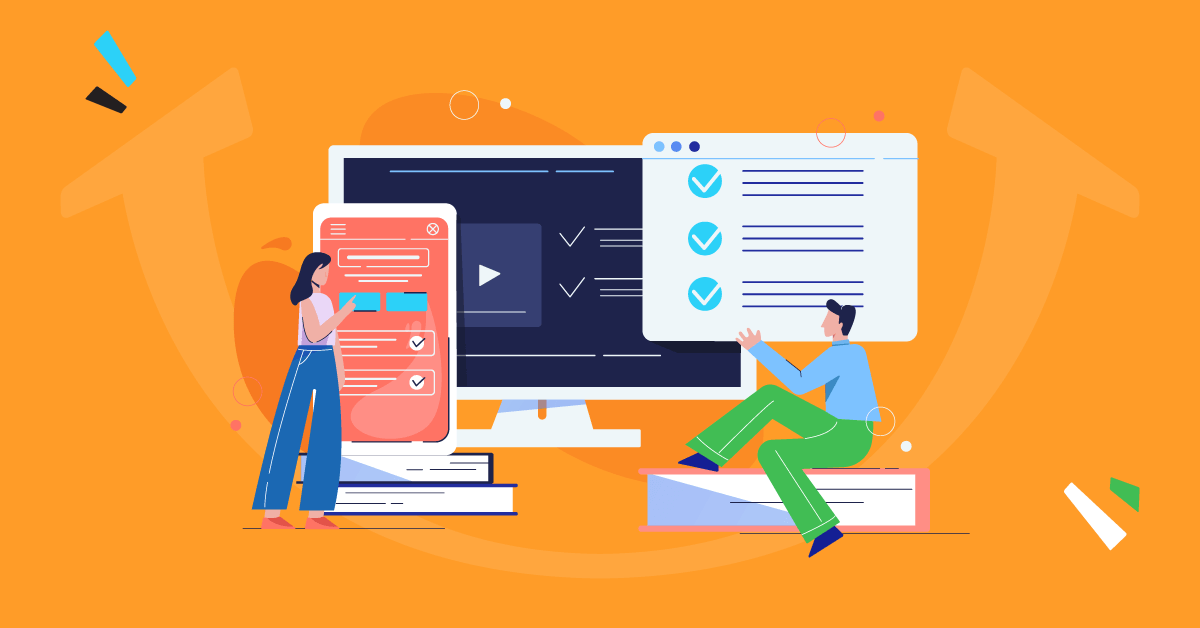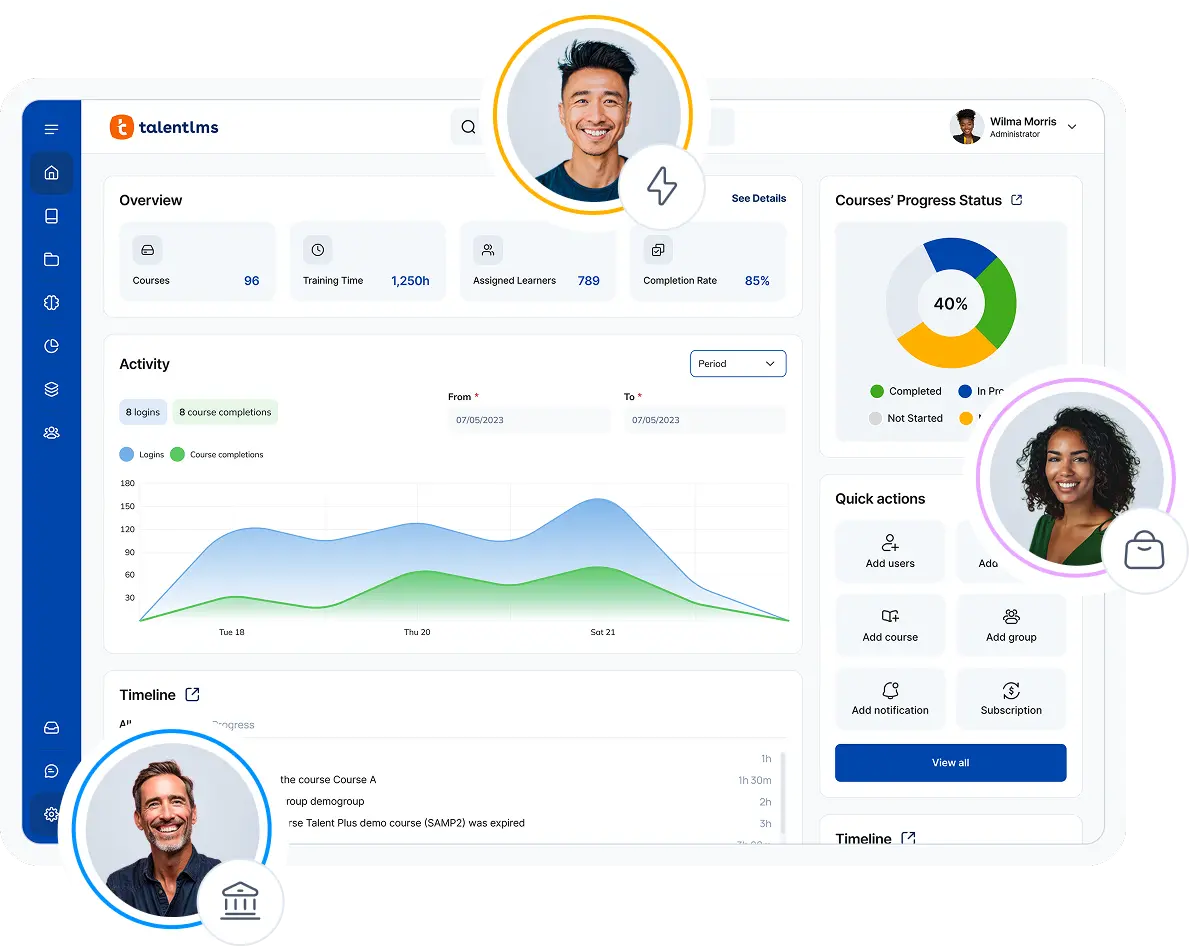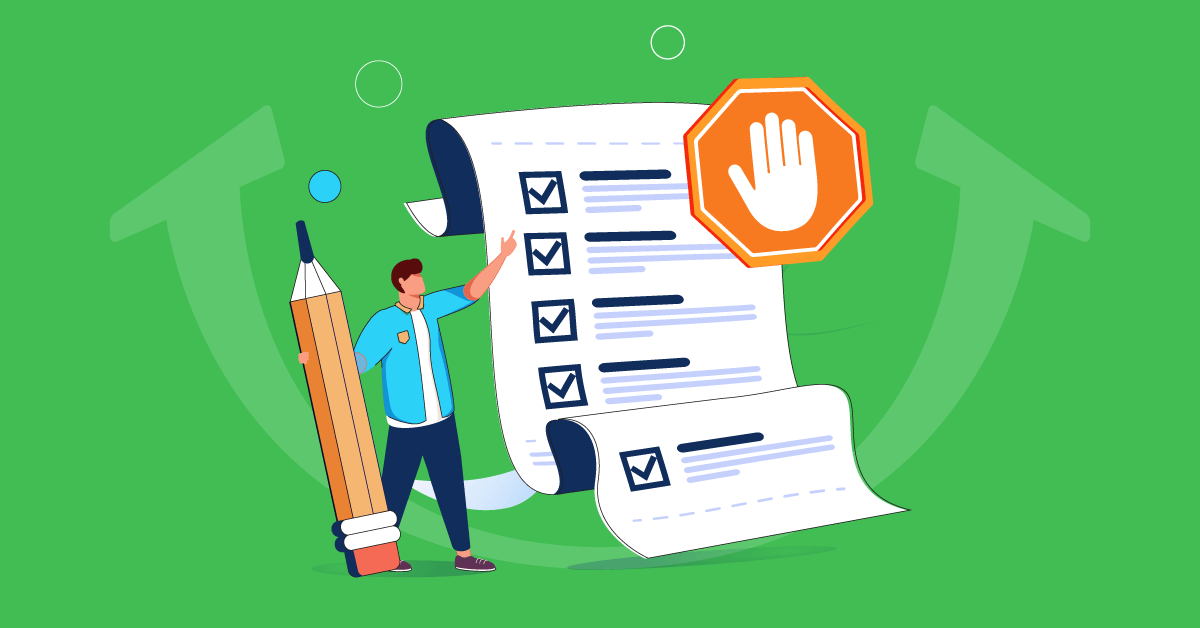Hybrid and remote teams and asynchronous working patterns. A global operation with an increasingly diverse workforce. Rapid technological change. A skills revolution. And, finally, budgetary constraints. These are just a few factors L&D teams face when designing and delivering training in the modern workplace.
Joining all of these dots is in everyone’s interest.
Successful training pairs with more engaged, loyal, and contented employees. It also equates to better-functioning, more productive, and profitable businesses. But covering everything on the list (every time) isn’t easy. The upside is, a training checklist can help you do just that.
Below are some of the most common employee training checklist templates. Use them as they are, or customize them as you need to. Either way, the result will be training designed to tick all the boxes. And more.
What is a training checklist?
A training checklist is a go-to guide for your employee training program. It’s a simple, organized, but comprehensive rundown of the key components of how to design top-tier training. It covers the four key stages of training: preparation, development, delivery, and evaluation. And, broken down, it ensures no relevant steps, tasks, topics, or targets get overlooked in any of those key stages.
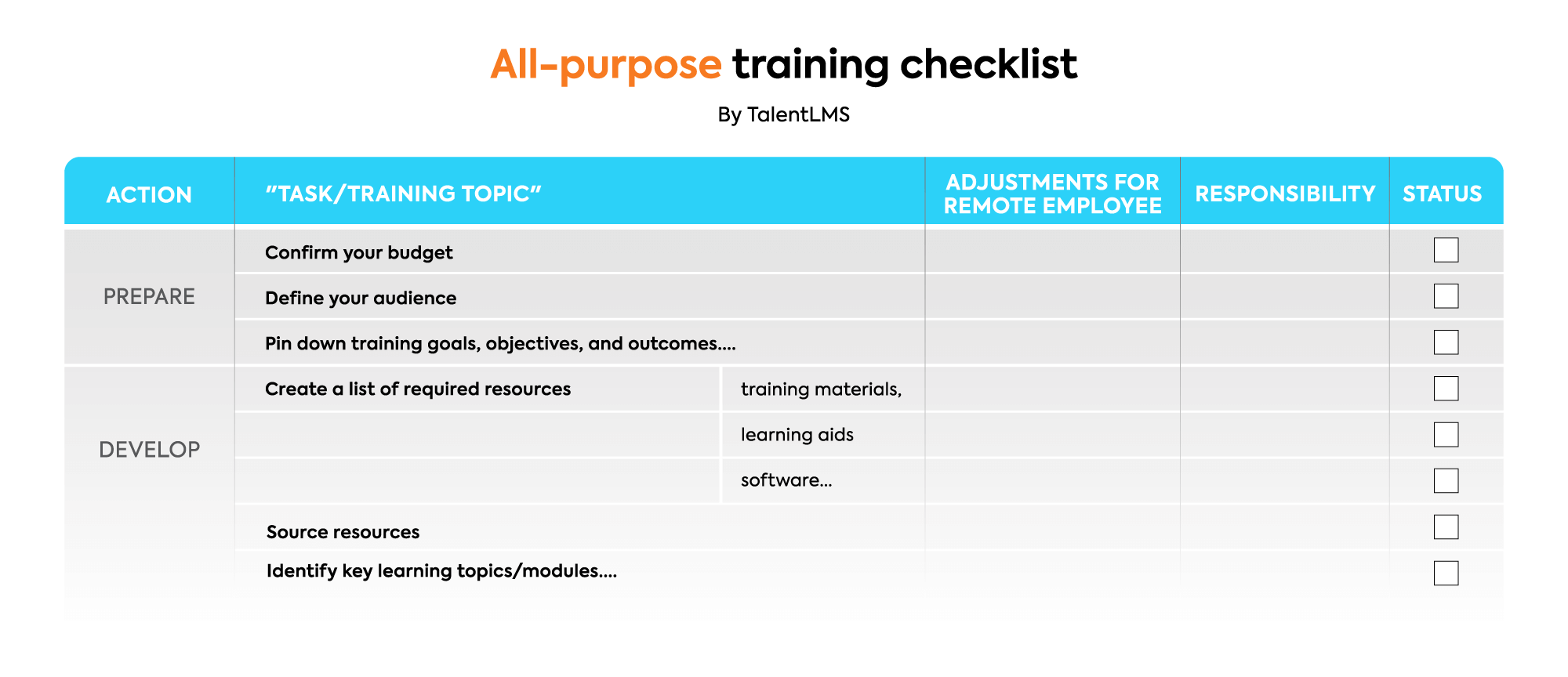
As a resource, its application across an organization is wide-ranging. Your training checklist might be used by:
- HR professionals to develop, implement, and monitor training programs. And to ensure they align with company goals.
- Trainers/training coordinators to deliver training, ensuring all key topics are covered.
- Managers/leaders to identify team needs and ensure effective skill-building.
- Employees/trainees to track learning goals, schedules, and evaluation criteria.
Why is a training checklist important?
The goal of employee training is simple—equip your employees with the knowledge and skills they need to do their jobs well. And leave them wanting more! Yet, according to TalentLMS benchmarking data, 63% of them say the training programs in their company could be improved.
An employee checklist can help L&D teams elevate training. Part organization, part inspiration—it’s not just about making training more efficient. It’s also about making it engaging and rewarding.
Here’s how it ticks both of those objectives off the list:
Consistent, correct, and complete
A training checklist ensures every employee gets the same thorough training, no matter who’s leading it or how it’s been delivered. It acts as a safety net, making sure there are no missed steps. And it helps reduce the risk of errors.
Effective, efficient, and easier to evaluate
With clear, documented objectives and a structured plan, trainers, and employees stay focused and on track. This, in turn, makes it easier for L&D teams to measure learning outcomes.
Caring, confident, and compliant
In highly regulated industries, training carries even greater weight because it becomes a legal requirement. For example, harassment, discrimination, and DEI training. In some instances, it’s also a critical safety measure. Think, for instance, OSHA standards, and forklift truck driving instruction. A training checklist provides a formal framework for all of these business-critical courses. And ensures that official L&D requirements are being managed and met.
Welcoming, and well-planned
For new hires, starting a new job can feel overwhelming and disorientating. A training checklist based on onboarding provides them with structure and focus. Which, in turn, makes the transition into a new role at a new company, easier. It also means every new hire feels invested in. And, broken down into essential tasks and learning goals, equipped with the knowledge and skills they need to start making their mark.
How to make a training checklist: 4 steps to follow

A training checklist can be used for different purposes, from onboarding and OSHA training to leadership development and skills-specific learning. It can be broad and generic. Or very specific, depending on your business type and industry.
In the construction industry, for example, you may want to create something as specific as a forklift training checklist. The checklist for each of these training types will differ in terms of detail, goals, and industry needs. But they should all follow a similar framework and apply some core principles.
Coming up, we provide ready-to-go training checklists for 8 of the most common types of corporate training. Let’s look at those key components and the steps you should take when creating your training checklist from scratch.
Step 1. Prepare
- Confirm your budget
- Define your audience
- Pin down training goals, objectives, and outcomes
- Set effectiveness and quality benchmarks (conduct pre-training assessments if required)
- Evaluate each trainee’s / team’s learning needs
- Work out a training schedule and timings for rollout
- Book venue (if appropriate)
- Check technical requirements
- Send out invites (and instructions on how to join/attend)
- Log attendee/participant numbers
Step 2. Develop
- Draft a detailed training outline
- Identify key learning topics/modules
- Align these topics/modules with specific training goals
- Sync learning topics/modules with relevant training activities/delivery methods
- Design and develop training content for each topic/module (including tasks and assessments)
- Create a list of required resources (training materials, learning aids, software, tools, handouts)
- Source resources
Step 3. Deliver
- Test technical equipment is in place and working
- Welcome learners
- Share the course program
- Support discussions and interactions
- Invite and answer questions
- Summarize key takeaways and next steps
Did you know? A quarter of all employees say technical issues hinder workplace learning.
Step 4. Review
- Gather learner data using: post-training assessments, manually collated information, automated reports
- Analyze data, including (where available): course completion rates, pass rates, test scores, time spent learning, progress through courses, engagement levels, activity logs
- Gather learner feedback using: group sessions, evaluation forms, surveys
- Acknowledge, analyze, and act on feedback
What makes a training checklist great?
We’ve covered what you need to do to create a standard training checklist. But how do you elevate it from an ordinary ‘to-do’ memo into an engaging and effective training support tool?
Clarify responsibilities
For every activity or task, allocate a task ‘owner’. This way, there will be accountability and ownership, which prevents miscommunication and delays. Plus, it ensures important steps aren’t overlooked, and all stakeholders know their role. Specifically:
- Trainers and coordinators cover the required topics in the right training sessions and provide the right support.
- HR teams, managers, and senior leaders can track progress, measure effectiveness, and provide support when needed.
- Trainees understand expectations and who to reach out to for guidance. This is particularly critical for new hire training.
Set deadlines
Without clear timeframes, your training checklist loses its purpose. Training becomes disorganized, leading to delays, inconsistent progress, and incomplete learning. Setting deadlines keeps training and targets on track. It also ensures that learning is aligned with business needs because employees have the skills they need when they need them. Thus avoiding workflow disruptions.
Your training checklist is a helpful reminder, not a step-by-step training guide. For it to be useful, it should be easy to understand, at-a-glance. Use simple, clear language. Include essential details only to avoid overwhelming users. And apply logic to its structure. Organize it in a way that makes sense to those using it. This could be by team, area, or department. Or even by format, priority, or milestones. Tip: Managing training programs in a learning management system effectively guarantees ease of access for all learners. (Hint: We cover more of the benefits of using an LMS to support your training checklist later in this section.) For most SMBs, designing a training checklist that’s 100% bespoke to each employee won’t be achievable. But some personalization goes a long way—boosting engagement, motivation, and overall learning effectiveness. There are a few simple ways you can customize it to make it feel more targeted. For example, create different versions according to role, working model (in-office vs. remote/hybrid employees), or different learning preferences (self-paced, instructor-led, or in-person training). You could also pair new hires with a mentor or buddy to provide guidance and answer questions. An easy way to add a personal touch is to incorporate your learner’s name within the checklist and in any supporting communications. A well-designed training checklist can be effective in its own right. But add a user-friendly LMS to the mix, and it steps up a level. Using Application Programming Interfaces (APIs), data from your training checklist can be synchronized and seamlessly shared with your learning platform. There are big benefits to integrating your training checklist with an LMS. Summarized, it makes the process more structured, automated, and scalable. It’s also easier to track. Using the info shared above, you should now have all you need to design your training checklist templates. But you don’t need to start from scratch. Whether you’re onboarding new employees, ensuring workplace safety, or developing leadership skills, we’ve produced eight training checklist templates you can use to speed up the process. And build a clear and efficient training process. Download, make a copy, adjust as needed, and then ‘save’. A general training checklist is your go-to framework for employees across various roles and departments. It lists all the key steps, from planning and designing to delivering and evaluating training. It can be used as is or customized to fit different training programs. Get your all-purpose training checklist. Onboarding sets the stage for a new hire’s ongoing experience at your company. But, according to Gallup, 88% of organizations get onboarding wrong. Using a new employee training checklist, you can provide all new hires with a consistent, structured experience when transitioning to a new role at your company. And set them off on a positive footing. A new hire training checklist covers everything from mandatory and job-specific training to company culture and policies. And is designed to guide new hires through the onboarding process and their first days, weeks, and months at your company. For a complete overview, use it with a new hire onboarding checklist, which covers every stage of the onboarding process up to the 90-day probationary period. Basic safety training is important in all workplaces. But for some industries, it’s far more complex and critical. Particularly in those high-stakes environments, a safety checklist protects employees and the organization by reducing risks and enhancing compliance. It helps maintain a safe work environment, preventing accidents, and ensuring employees understand their responsibilities in case of an emergency. Get your safety training checklist. OSHA training is a specific form of safety training mandated in the US by the Occupational Safety and Health Administration. It ensures that businesses formally comply with regulations and covers critical topics such as hazard communication, emergency procedures and action plans, fire safety, exit routes, and proper use of personal protective equipment (PPE). This checklist helps organizations systematically deliver and document required training, reducing the risk of workplace accidents, legal penalties, and non-compliance issues. Tip: For regulated training such as OSHA, it’s important to review your OSHA-required training checklist (general industry version) each year to ensure it’s up-to-date and reflects the latest developments in legislation. 5. Leadership training checklist template A leadership training checklist template is used to develop essential skills for managers, team leaders, and supervisors. Covering topics such as communication skills, conflict resolution, decision-making, team motivation, and strategic thinking, it helps organizations cultivate strong, confident, inspirational leaders. By using a leadership training checklist, businesses can create a more cohesive, productive work environment while preparing future leaders for long-term success. Get your leadership training checklist. Employees who truly understand your company’s portfolio of offerings are key to boosting your bottom line. A product/service training checklist is a vital support tool for sales, customer support, and marketing teams. It helps them communicate effectively with customers, answer questions confidently, and provide accurate recommendations. This boosts customer satisfaction and sales performance. Plus, it means employees are well-equipped to represent your brand and business offering consistently and professionally. Get your product/service training checklist. Within the workplace, there are essential topics businesses are legally obliged to provide employees with training on. A compliance training checklist includes courses on data privacy, workplace safety, anti-harassment policies, and other industry-specific regulations. It provides a safety net to employers by ensuring that employees understand and adhere to legal, regulatory, and company policies relevant to their roles. This, in turn, protects organizations against potential violations, while also protecting their reputation as a responsible employer. Get your compliance training checklist. When employees in externally-facing roles have the skills and knowledge needed to engage customers, drive sales, and provide exceptional service, everyone wins. A sales and customer service training checklist is designed to boost confidence and improve customer interactions. Which ultimately enhances customer satisfaction and loyalty. It covers key areas such as product knowledge, communication techniques, handling objections, active listening, and conflict resolution. Get your sales/customer service training checklist. A training checklist isn’t just a to-do list. It sets standards for training. It indicates a commitment to training and a culture of learning and development. It also elevates the importance of training and can become a dynamic, future-ready tool for workforce development. Not just a static, administrative process. Learning and development trends change. This means training checklists need to change too. So treat your checklist as an organic entity. By doing so and by integrating clear objectives, personalized learning paths, and ongoing feedback, training checklists become a fluid roadmap for professional growth, not just a formality. Businesses that treat training as a continuous journey rather than a one-time event will see greater engagement, higher retention, and a more capable workforce. Not a bad ROI for a checklist.Boost accessibility
Make it personal
Use an LMS
Reasons to use an LMS for training
8 training checklist templates
1. All-purpose training checklist template
2. Onboarding training checklist template
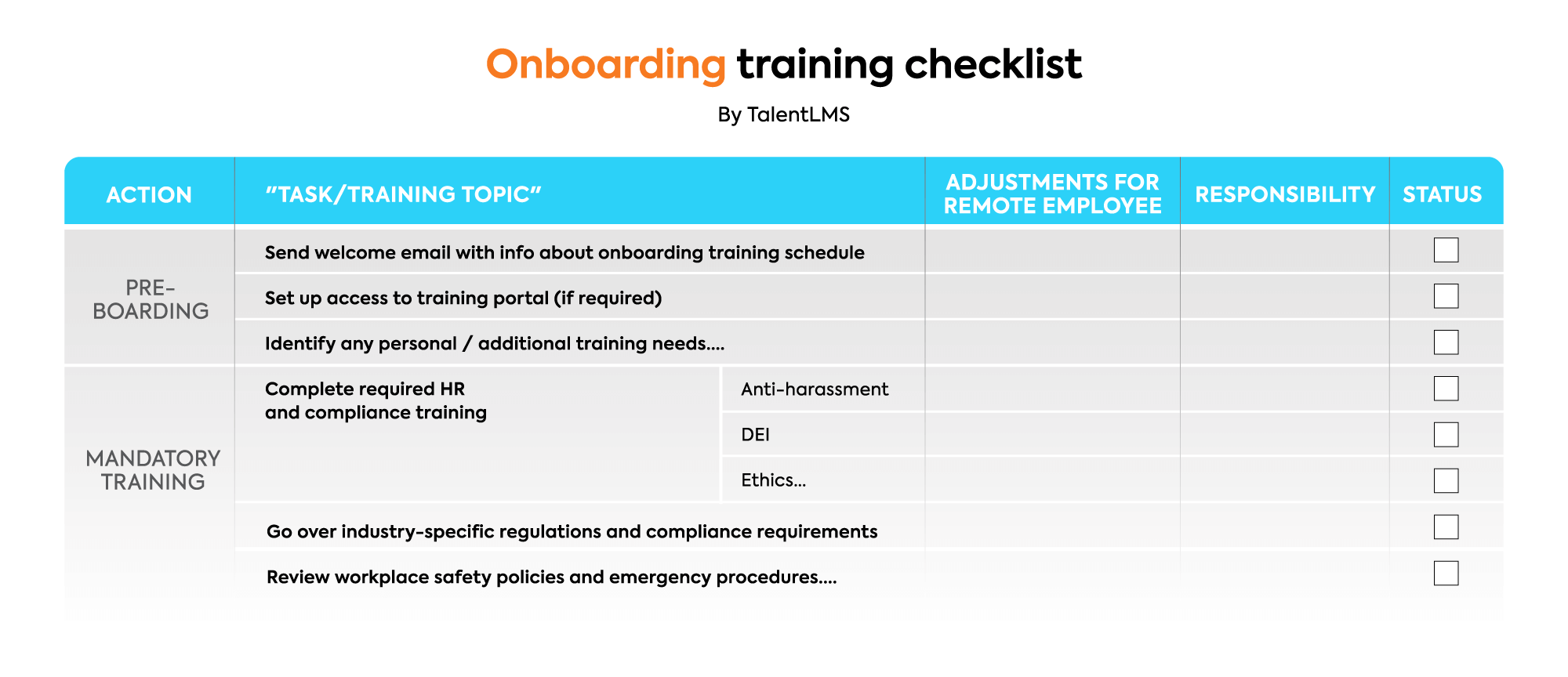 Get your onboarding training checklist.
Get your onboarding training checklist.3. Safety training checklist template
4. OSHA-required training checklist template
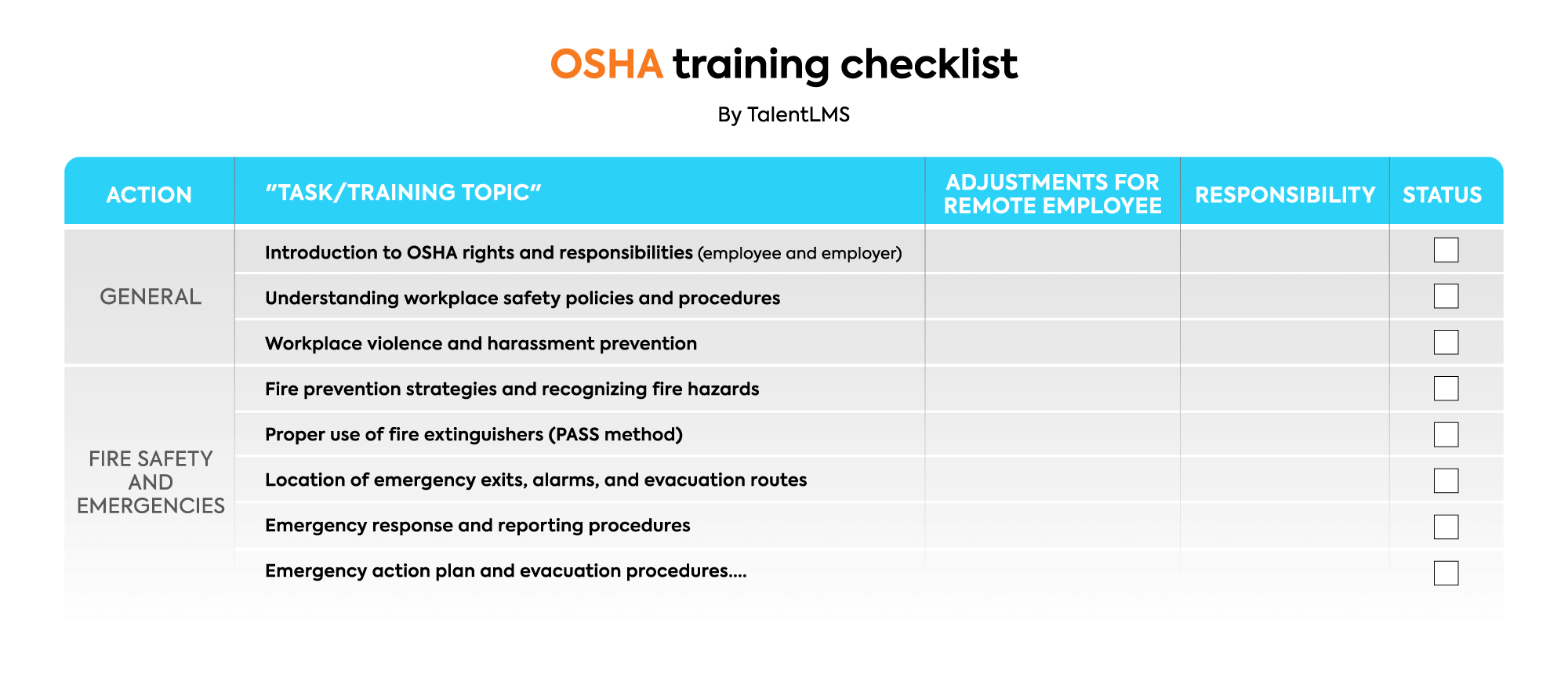 Get your OSHA-required training checklist.
Get your OSHA-required training checklist.6. Product/service training checklist template
7. Compliance training checklist template
8. Sales/customer service training checklist template
Your go-to training checklist: More than a tick-box
| Tags: Compliance Training,Employee Training,Leadership training
